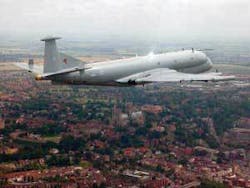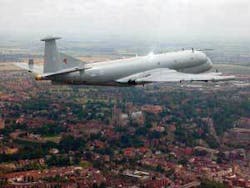Northrop Grumman flight tests new electro-optical surveillance and detection system
ROLLING MEADOWS, Ill. - Northrop Grumman Corp. experts in Rolling Meadows, Ill., are flight testing a the new electro-optical surveillance and detection system (EOSDS) for the United Kingdom Ministry of Defence’s Nimrod MRA-4 aircraft.
Nimrod MRA-4 is going through extensive flight trials for which BAE Systems is the prime contractor. For its part in the two-year Nimrod MRA-4 in-service reliability maintainability demonstration program, Northrop Grumman’s Defensive Systems Division in Rolling Meadows, Ill., is providing flight-test support to include software development and flight test personnel training in addition to fielding inquiries regarding the system.
EOSDS is a gimbal-mounted electro-optical system designed to give the Royal Air Force the capability to observe and track targets of interest in the visible and infra-red spectrums by means of a television camera and two thermal-imaging cameras.
EOSDS has three detection modes and can automatically track targets through nadir to allow continuous surveillance even when overflying a target.
These flight tests mark the first production aircrafts to integrate and operate the EOSDS systems during the Nimrod Flight Test Program. The purpose of the initial flights was to assess the aerodynamic effects of the deployment and retraction of EOSDS as well as to determine the influence of opening the bomb bay doors of the Nimrod MRA-4.
During these test flights to date, the system was deployed at 5,000 feet and remained deployed up to 10,000 feet while flight operators tested all three EOSDS sensors and examined the aerodynamic effect on the aircraft.
“Integration of the EOSDS system on the MRA-4 aircraft will provide the Royal Air Force with alternative capabilities for conducting maritime surveillance while protecting the United Kingdom’s coastal waters,” says Mike Lennon, vice president of targeting and surveillance programs at Northrop Grumman’s Defensive Systems Division. “Employment of Northrop Grumman’s surveillance systems on long-endurance surveillance platforms like the Nimrod MRA-4 strengthens the mission capabilities of our allies.”
The first flights of the EOSDS system onboard the Nimrod MRA-4 aircraft were accomplished through the combined efforts of the U.K. Ministry of Defence, Royal Air Force, BAE Systems, the Boeing Co., and Northrop Grumman’s Defensive Systems Division.

